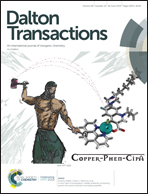Synthesis and structural characterization of homochiral coordination polymers with imidazole-based monocarboxylate ligands†
Abstract
Chiral Na[(S)-LR] (R = Me, 1a; iPr, 1b; CH2iPr, 1c, and (S)-secBu, 1d) and Na[(R)-LR] (R = Me, 1a′) compounds were synthesised following standard procedures. New compounds 1d and 1a′ were analytically and spectroscopically characterised. 1a and 1c were structurally identified by single-crystal X-ray diffraction methods as homochiral 2D coordination polymers, {Na(H2O)[(S)-LMe]}n and {Na[(S)-LCH2iPr]}n, respectively. Both (S)-2alkyl,2-(1H-imidazol-1-yl)acetate anions displayed unprecedented coordination modes in these coordination polymers: μ3κ2OκO′ for 1a and μ4κ2Oκ2O′ for 1c. Enantiomeric species 1a′, {Na(H2O)[(R)-LMe]}n, showed the same X-ray powder diffractogram (XRPD) as 1a, in agreement with a similar crystal structure. DFT calculations on the [LR]− anions confirmed their coordination capabilities as ditopic linkers. In fact, the reaction of Na[LR] with several metal salts yielded the following coordination polymers: {Ag[(S)-LMe]}n, 2a, {Ag[(R)-LMe]}n, 2a′, {Cu[(S)-LR]2}n (R = Me, 3a; iPr, 3b), {Cu[(R)-LMe]}n, 3a′, {Zn[(S)-LR]2}n (R = Me, 4a; iPr, 4b; (S)-secBu, 4d) and {Zn[(R)-LMe]2}n, 4a′. For the known compounds 3a and 4a, this procedure is a new synthetic route that avoided high temperature reaction conditions. New complexes 2, 3a′, b, and 4a′, b, d were characterised by elemental analysis, infrared and XRPD methods and complex 2a by single-crystal X-ray diffraction. This complex is also a two-dimensional coordination polymer in which the [(S)-LMe]− anion acts as a μ4κN,κ2O,κ2O′ bridging ligand. Compounds 1–4a′ are the first examples of homochiral coordination polymers with imidazole-monocarboxylate ligands based on non-natural amino acids. Preliminary studies on the metal-catalysed preparation of chiral α-aminophosphonates were carried out but, unfortunately, no enantioselectivity was observed.

- This article is part of the themed collection: Nitrogen Ligands


 Please wait while we load your content...
Please wait while we load your content...